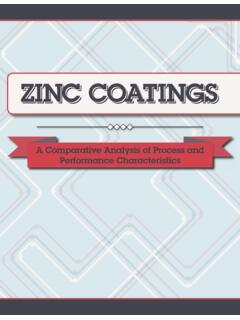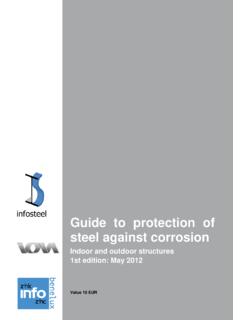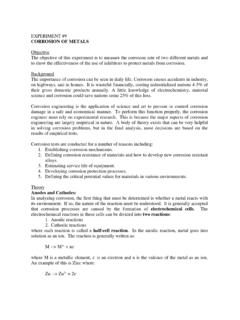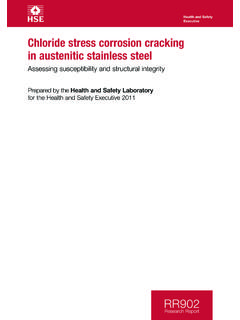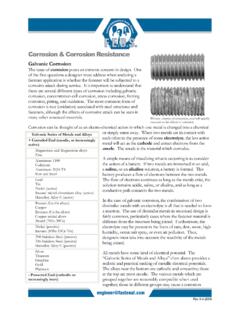Transcription of HOT-DIP GALVANIZING FOR CORROSION PROTECTION
1 HOT-DIP GALVANIZING FOR CORROSION PROTECTIONa specifier s guideamerican galvanizers associationAmerican Galvanizers Association2 2012 American Galvanizers Association. The material provided herein has been developed to provide accurate and authoritative information about after-fabrication HOT-DIP galvanized steel . This material provides general information only and is not intended as a substitute for competent professional examination and verification as to suitability and applicability. The information provided herein is not intended as a representation or warranty on the part of the AGA.
2 Anyone making use of this information assumes all liability arising from such use. HOT-DIP GALVANIZING FOR CORROSION PROTECTIONa specifier s guideCorrosion What & WhyCorrosion ProcessHot-Dip GALVANIZING (HDG) HistoryProcessWhy Specifiers Choose HDGC orrosion ProtectionBarrier, Cathodic, Zinc PatinaDurabilityAbrasion ResistanceUniform ProtectionComplete CoverageLongevity AtmosphereSoilWaterConcrete Other EnvironmentsAvailability & VersatilityAbundant MaterialsEfficiencyFlexibilityAesthetics Natural/BlendingArchitectural ApplicationsDuplex SystemsSustainabilityEnvironmentalEconom icSpecifying HDGC onclusionAmerican Galvanizers Association3 CORROSION .
3 What & why CORROSION and repair of CORROSION damage are multi-billion dollar problems the latest estimates show metallic CORROSION costs the United States approximately $423 billion annually ($52 billion in Canada), or about 3% of each nation s GDP. However, the cost of CORROSION is much greater than just financial, it can also lead to waste of natural resources, hazardous failures, and many other indirect costs. CORROSION is a natural phenomenon which can never be completely eliminated; however, it is a misconception nothing can be done.
4 Employing adequate CORROSION PROTECTION systems at the start of a project, such as HOT-DIP GALVANIZING , can significantly reduce these annual costs. For more than 100 years, HOT-DIP GALVANIZING after fabrication has been specified to combat steel CORROSION in the harshest environments throughout various markets. However, the specification and use of HOT-DIP galvanized steel evolves constantly as new markets emerge. Once considered only as a means of CORROSION PROTECTION , HOT-DIP GALVANIZING is now specified for an array of reasons including lower initial cost, durability, longevity, availability, versatility, sustainability, and even aesthetics.
5 Understanding the characteristics and performance of HOT-DIP galvanized steel will facilitate and increase the specification of the coating in applications where GALVANIZING will enhance the processCorrosion, which can be simply defined as rust, is more appropriately the tendency for metals to revert to their natural, lower energy state of ore. Metallic CORROSION is an electrochemical process meaning it involves both chemical reactions and the flow of electrons. A basic electrochemical process that drives the CORROSION of metals is galvanic action, where current is generated internally by physical and chemical reactions occurring among the components of the cell.
6 CORROSION costs the US$423 BILLION annuallyAmerican Galvanizers Association4galvanic corrosionThere are two primary types of galvanic cells that cause CORROSION : the bimetallic couple and the concentration cell. A bimetallic couple (Figure 1) is like a battery, consisting of two dissimilar metals immersed in an electrolyte solution. An electric current (flow of electrons) is generated when the two electrodes are connected by an external continuous metallic path. A concentration cell consists of an anode and cathode of the same metal or alloy and a return current path.
7 The electromotive force is provided by a difference in concentration of the solutions contacting the metal(s). In a galvanic cell, there are four elements necessary for CORROSION to occur: Anode - Electrode at which negative ions are discharged and positive ions are formed, or other oxidizing reactions occur. CORROSION occurs at the anode. Cathode - Electrode at which positive ions are discharged, negative ions are formed, or other reducing reactions occur. The cathode is protected from CORROSION .
8 Electrolyte - Conducting medium in which the flow of current is accompanied by movement of matter. Electrolytes include water solutions of acids, bases, and salts. Return Current Path - The metallic pathway connecting the anode to the cathode. It is often the underlying any one of these elements will stop the current flow and CORROSION will not occur. Substituting a different metal for the anode or cathode may cause the direction of the current to reverse, resulting in a change of the electrode experiencing galvanic series lists metals and alloys in decreasing order of electrical activity.
9 Metals toward the top of the list are less noble and have a greater tendency to lose electrons than metals found lower on the list. Utilizing HOT-DIP galvanized steel exploits this phenomenon by sacrificing zinc (anode) to protect the underlying steel (cathode). CORROSION of steelThe CORROSION process that takes place on a piece of bare steel is very complex due to variations in the composition/structure of the steel , presence of impurities due to the higher instance of recycled steel , uneven internal stress, or exposure to a non-uniform environment.
10 It is easy for microscopic areas of the exposed metal to become relatively anodic or cathodic, and many of these areas can develop in a small section of the exposed metal. Therefore, it is highly possible several different galvanic CORROSION cells are present in the same small area of the actively corroding piece of steel . +-ExternalCircuitElectrolyteCONVENTIONAL CURRENTE lectronsElectronsAnodeCathodeFigure 1: Bimetallic CoupleAmerican Galvanizers Association4 American Galvanizers Association5 HOT-DIP GALVANIZING (HDG)As the CORROSION process progresses, the electrolyte may change due to materials dissolving in or precipitating from the solution.






